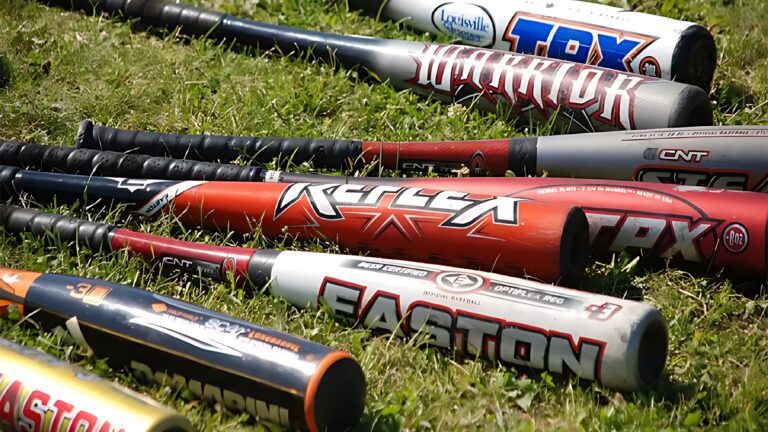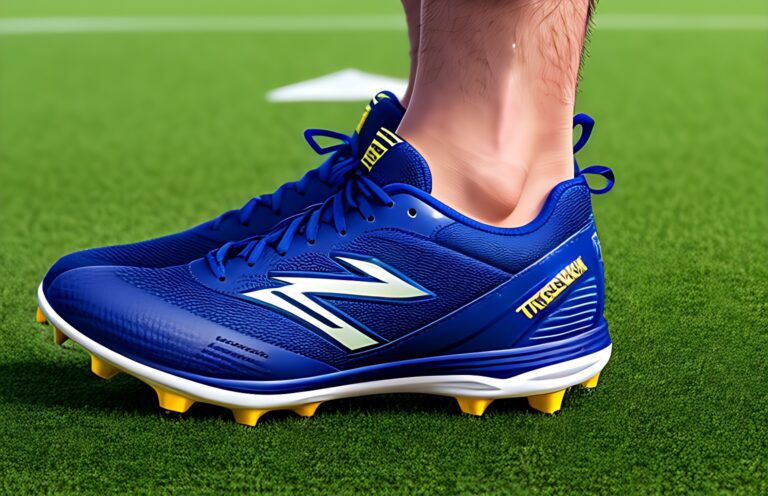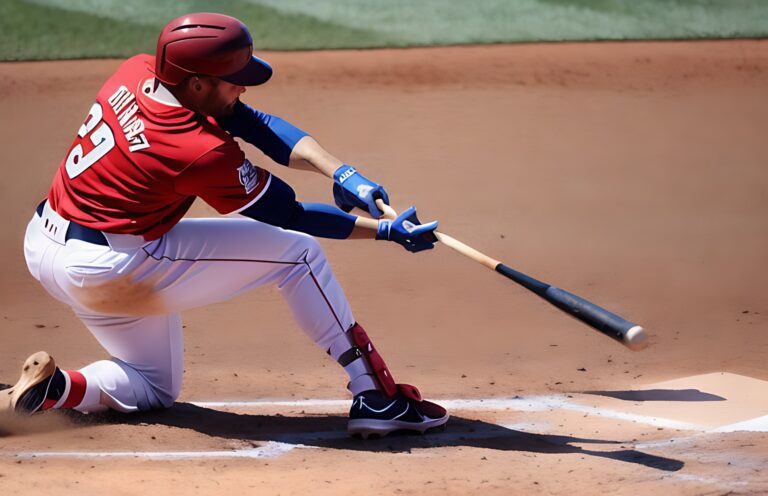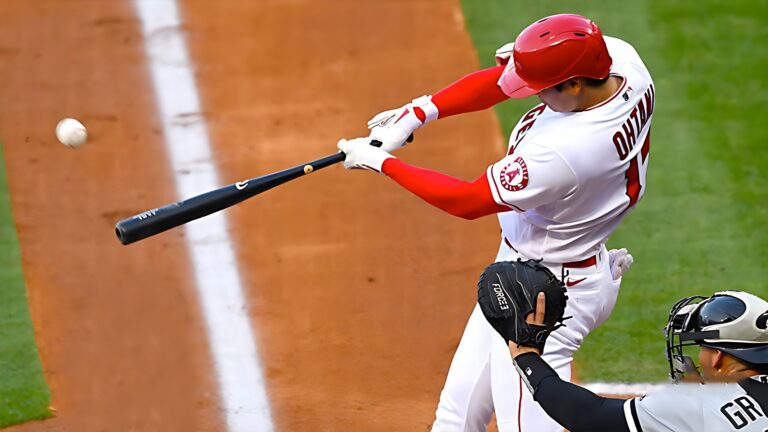Why Do Baseball Players Use Wooden Bats?
Have you ever wondered, why do baseball players use wooden bats? It’s a question that has piqued the curiosity of many fans and enthusiasts.
However, the truth is that wooden bats not only add a traditional charm to the game but also serve a crucial purpose. They ensure the safety of the defending infielders, as balls aren’t propelled with the same speed or frequency as they would be with metal bats. This reduces the risk of injuries on the field.
Moreover, wooden bats are more cost-effective to manufacture. This means that when a player breaks a bat, it’s easy and affordable to replace. So, the use of wooden bats in baseball is a blend of safety, tradition, and practicality.
See Also: Best BBCOR Bats
The Historical Roots of Wooden Bats: From Stick Swings to Baseball Legends
Long before the crack of the bat echoed across stadiums, baseball players relied on something far more humble: the trusty wooden bat. As we delve into the historical roots of these iconic tools of the trade, prepare to journey back to the early days of America’s beloved pastime.
A Swing Through Time
Imagine this: it’s the mid-19th century, and baseball is slowly gaining traction as a national obsession. Back then, players didn’t have the luxury of sporting shiny aluminum or composite bats. Instead, they wielded something much more rustic—wooden bats that often started their lives as little more than crude sticks.
From Homemade to Standardized
In those early years, players took it upon themselves to fashion their bats, often handcrafting them from whatever wood they could find. These homemade bats were far from uniform, varying in length, thickness, and shape. Each player had their unique weapon of choice, giving rise to a diverse arsenal of bats on the field.
But as baseball’s popularity surged, so did the need for standardization. The late 19th century saw the emergence of professional bat makers who began producing wooden bats on a larger scale. These bat artisans honed their craft, refining the shape, weight, and balance of the bats to suit the needs of the players.
Pioneering Innovations
As baseball evolved, so did the technology behind wooden bats. In the early 20th century, players witnessed the introduction of lathed bats, crafted by spinning them on a machine to achieve a more uniform shape. This innovative technique paved the way for consistent bat production and heightened player performance.
But the quest for the perfect bat didn’t stop there. Manufacturers experimented with different woods, seeking the ideal combination of strength, flexibility, and durability. From traditional ash to sturdy maple, each wood brought its unique characteristics to the plate, and players eagerly embraced the options.
The Legends’ Weapon of Choice
As the game grew, wooden bats became synonymous with baseball legends. Think of Babe Ruth, the Sultan of Swat, gripping his mighty ash bat, or Ted Williams and his trusty maple companion. Wooden bats were more than just tools; they were an extension of the player’s personality, their go-to instrument for making history on the field.
A Tradition That Endures
In an era where technology and innovation rule the sports landscape, it’s remarkable that wooden bats remain an integral part of the game. Their enduring presence pays homage to baseball’s rich history and the deep-rooted connection between player and bat.
So, the next time you hear the distinct crack of a wooden bat, take a moment to appreciate the journey it has taken—from a humble stick swung in sandlots to a symbol of baseball greatness. The historical roots of wooden bats remind us of the sport’s foundation and the legends who shaped it with every swing.
See Also: Best USSSA Bats
The Advantages of Wooden Bats: Unleashing the Magic of Timber Swingers
When it comes to the art of baseball, there’s something undeniably captivating about the crack of a wooden bat meeting a speeding fastball. But what makes these classic timber swingers so special? Let’s dive into the advantages that wooden bats bring to the game, leaving players and fans spellbound.
The Perfect Balance
One of the key advantages of wooden bats lies in their balance. Crafted from carefully selected woods like ash, maple, or birch, these bats strike the perfect equilibrium between weight and maneuverability. With each swing, players can feel the bat glide effortlessly through the strike zone, giving them optimal control over their hitting prowess.
Skill Development Unleashed
While metal or composite bats may offer a spring-like effect, wooden bats demand a higher level of skill from the players. The unforgiving nature of timber requires batters to refine their technique, enhancing their hand-eye coordination and timing. Swinging a wooden bat is a masterclass in precision, making it the perfect tool for players to sharpen their skills and unleash their full potential.
Embracing the Sweet Spot
Ah, the elusive sweet spot—the hallowed area on the bat that produces that euphoric sensation of a solidly hit ball. Wooden bats excel in helping players find and connect with the sweet spot. The absence of high-tech innovations means that hitters must rely on their technique and instinct, training their senses to locate that sweet spot and send the ball soaring toward greatness.
A Touch of Tradition
In a world of constant change, wooden bats serve as a symbol of tradition and nostalgia. From sandlot games to the biggest stages of professional baseball, the rich history and time-honored tradition of wooden bats evoke a sense of reverence and respect. Players who step up to the plate with a wooden bat in hand carry on a legacy that connects them to the game’s pioneers and legends.
The Unique Sound and Feel
There’s nothing quite like the distinct sound and feel of a wooden bat meeting a baseball. The crack reverberates through the stadium, eliciting cheers or groans from the crowd. And the tactile feedback of a wooden bat connecting with a pitch is unmatched—players can sense the vibrations and feedback that guide their next move, creating an intimate connection between the bat and the batter.
Bringing Baseball’s Essence to Life
Wooden bats embody the very essence of baseball itself. They pay homage to the game’s humble origins and its evolution over time. Using a wooden bat connects players to the history, spirit, and purity of the sport. It’s a reminder that baseball isn’t just about statistics and records—it’s about passion, grit, and the magic that happens when wood meets leather.
See Also: Best Baseball Bats Under $300
The Science Behind Wooden Bats
In the world of baseball, the crack of a wooden bat against a speeding fastball is a symphony of precision and power. But have you ever wondered about the science behind the timber’s triumph? Prepare to delve into the fascinating realm where physics, materials, and craftsmanship converge to give wooden bats their extraordinary capabilities.
The Perfect Physics
When it comes to bat performance, physics plays a pivotal role. The design and construction of a wooden bat can significantly influence a player’s swing and the ball’s trajectory upon impact. Factors such as weight distribution, bat speed, and the collision between bat and ball are all governed by the principles of motion and energy transfer.
Wood’s Wonders
Wood, as a material, possesses unique properties that contribute to a wooden bat’s performance. Each wood species—whether it’s ash, maple, or birch—has its own characteristics, such as density, stiffness, and flexibility. These properties affect how the bat interacts with the ball, influencing factors like exit velocity and ball spin.
Bat Density and Responsiveness
The density of the wood used in a bat affects its responsiveness upon contact with the ball. Bats with lower density, such as ash, tend to have more “give,” absorbing some of the ball’s energy and reducing vibrations. On the other hand, denser woods like maple provide a stiffer response, resulting in greater ball exit speeds. It’s a delicate balance between responsiveness and durability that bat makers carefully consider.
Grain Orientation and Durability
The orientation of wood grain within a bat also affects its performance and durability. The grain’s direction influences how the bat flexes and withstands the forces generated during a swing. Bat makers strategically align the grain to optimize the bat’s strength and minimize the risk of breakage, ensuring a longer lifespan on the field.
Moisture Content and Consistency
Wooden bats are highly sensitive to changes in moisture content. The moisture level affects the bat’s weight, density, and overall performance. Bat manufacturers carefully control the drying process, aiming for an ideal moisture content that provides stability and consistency in bat performance. Properly seasoned wood minimizes variations in weight and properties, giving players a more predictable experience.
The Role of Bat Design
Bat design has come a long way from its humble origins. Today, manufacturers use cutting-edge technology, such as computer modeling and data analysis, to refine bat shapes and optimize performance. Innovations in handle thickness, barrel taper, and knob design all aim to improve the bat’s balance, swing speed, and sweet spot effectiveness.
Balancing Power and Control
Wooden bats strike a delicate balance between power and control. While they may not offer the same trampoline effect as metal or composite bats, they reward the batter’s technique and skill. Hitters must channel their strength and precision, leveraging the bat’s mechanics to maximize power and accuracy. Wooden bats demand a higher level of mastery, turning each swing into a harmonious blend of finesse and raw power.
See Also: Best Baseball Bats for High School
Wooden Bats in Professional Baseball: Where Legends Swing for Greatness
Step onto the hallowed grounds of Major League Baseball, and you’ll witness a symphony of wooden bats unleashing the raw power and finesse of the game’s greatest athletes. Wooden bats have become synonymous with professional baseball, with their use deeply ingrained in the sport’s history and the pursuit of greatness. Let’s explore the profound impact and significance of wooden bats in the realm of professional baseball.
A Tradition Carved in Wood
For over a century, professional baseball has embraced wooden bats as the weapon of choice. From the days of Babe Ruth’s towering home runs to the modern-day feats of Mike Trout and Mookie Betts, wooden bats have witnessed the rise of legends and the rewriting of records. The tradition of swinging wooden bats connects today’s players to the trailblazers who came before, creating a sense of continuity that stretches across generations.
Striking the Right Balance
In the realm of professional baseball, wooden bats strike the perfect balance between power and precision. Each player seeks a bat that suits their unique style and preferences, fine-tuning their swing with meticulous attention to detail. The weight, length, and handle thickness of a wooden bat can be customized, allowing players to optimize their performance and find the perfect tool to conquer the challenges on the diamond.
A Test of Skill and Technique
Unlike their metal or composite counterparts, wooden bats demand a higher level of skill and technique from the players. Hitting with a wooden bat requires precision, timing, and an intimate understanding of the craft. The unforgiving nature of timber compels hitters to refine their swing mechanics, hand-eye coordination, and pitch recognition to unlock the full potential of their batting prowess.
The Art of Bat Selection
In the professional ranks, selecting the right bat is an art form in itself. Players carefully assess various factors, such as wood species, density, and performance characteristics when choosing their weapon. Ash, maple, and birch bats each offer their distinct advantages, allowing players to tailor their bats to their strengths and adapt to different pitching styles. The bat becomes an extension of the player, a trusted companion in the pursuit of greatness.
Bat Regulations and Safety Standards
Professional baseball leagues, including Major League Baseball (MLB), enforce strict regulations and safety standards for wooden bats. These rules govern bat dimensions, weight, and performance to ensure a level playing field and maintain player safety. By adhering to these guidelines, players compete on a fair and balanced stage, where the outcome is determined by skill, strategy, and a touch of baseball magic.
The Unbreakable Bond
Wooden bats in professional baseball represent more than just a tool for hitting balls—they embody the spirit and essence of the game. They are witness to the moments that etch themselves into baseball lore, capturing the hopes, dreams, and triumphs of both players and fans. The unforgettable crack of a wooden bat connecting with a baseball is a timeless symphony, an embodiment of the beauty and drama that captivates us on the diamond.
See Also: Best Wooden Baseball Bats Under $100
Wooden Bats in Amateur Baseball
Beyond the bright lights of professional stadiums, in the realm of amateur baseball, a different kind of magic unfolds. Here, young players, college athletes, and weekend warriors wield wooden bats, chasing their dreams with unwavering passion. Let’s explore the world of wooden bats in amateur baseball, where aspirations take flight and the love for the game burns brightly.
Honing Skills, Embracing Tradition
Amateur baseball provides a fertile ground for aspiring players to develop their skills and forge their identities on the field. Embracing the tradition of wooden bats connects these players to the roots of the game, carrying on a legacy that stretches back through time. By swinging wooden bats, they pay homage to the greats who came before them and strive to leave their own mark on the sport.
A Rite of Passage
For many young players, transitioning from metal or composite bats to wooden bats marks a significant milestone in their baseball journey. The switch to wooden bats symbolizes a step towards a higher level of competition and a test of their abilities. It challenges them to adapt their swing mechanics, refine their technique, and tap into their raw talent, uncovering new layers of their potential as they take on the distinctive challenges that wooden bats present.
The Art of Wood Selection
In amateur baseball, players often have the freedom to select the wood for their bats, exploring different options and finding the perfect fit for their style of play. Whether it’s the tried-and-true ash, the sturdy maple, or the versatile birch, each wood type offers its own set of characteristics and performance qualities. Choosing the right wood becomes an art form—a personal expression of the player’s preferences and a strategic decision to optimize their performance.
Skill Development and Personal Growth
Amateur baseball players wielding wooden bats embark on a journey of skill development and personal growth. The unforgiving nature of wooden bats demands a higher level of precision, encouraging players to refine their swing mechanics, enhance their hand-eye coordination, and deepen their understanding of the game. With every swing, players become more disciplined, more adaptable, and more resilient, fostering qualities that extend far beyond the diamond.
A Level Playing Field
In amateur baseball, wooden bats create a level playing field where talent and skill shine through. Unlike the high-performance characteristics of metal or composite bats, wooden bats reward players who master the fundamentals of the game. They emphasize the importance of technique, strategy, and the ability to adapt to different pitching styles. It’s a beautiful balance between challenge and reward, where true talent finds its voice.
Creating Lasting Memories
The memories forged in amateur baseball, with wooden bats at the heart of the action, are truly special. The crack of the bat, the camaraderie in the dugout, and the jubilation of a hard-earned victory or the lessons learned in defeat—all become indelible imprints in the hearts and minds of these aspiring stars. Wooden bats become cherished symbols of the journeys taken, the friendships formed, and the unbreakable love for the game.
See Also: Best Baseball Bats for 8 Year Olds
Safety Concerns and Risk Management
While baseball is a game of passion, skill, and camaraderie, it’s crucial to address safety concerns and implement effective risk management strategies to protect the players who grace the diamond. From youth leagues to the professional ranks, the well-being of baseball’s warriors is of paramount importance. Let’s delve into the realm of safety concerns and the proactive measures taken to ensure a safe and enjoyable experience for all involved.
Prioritizing Player Safety
Player safety is the cornerstone of any baseball program. Whether it’s in batting cages, during practice sessions, or in the heat of a game, measures must be in place to safeguard the players from potential risks and injuries. This commitment to safety reflects the genuine concern for the well-being of the athletes who make the game come alive.
Equipment Standards and Regulations
Baseball’s governing bodies, leagues, and organizations establish equipment standards and regulations to minimize risks and enhance player safety. From helmets to catchers’ gear, and yes, even the bats themselves, stringent guidelines ensure that the equipment used on the field meets the necessary safety requirements. By adhering to these standards, players can compete with confidence, knowing that their equipment has undergone thorough testing and meets established safety benchmarks.
Education and Training
Education plays a vital role in risk management within the realm of baseball. Coaches, players, and parents must be knowledgeable about the fundamentals of the game, proper techniques, and safety protocols. By providing comprehensive training and educational resources, the baseball community can foster a culture of safety, empowering individuals with the necessary knowledge to identify potential risks and take appropriate preventive measures.
Injury Prevention Programs
Prevention is always better than cure, and that holds true in baseball. Injury prevention programs aim to reduce the occurrence of common injuries and mitigate risks associated with the sport. These programs typically include warm-up exercises, strength and conditioning regimens, and techniques to enhance body mechanics. By focusing on proactive measures, such as proper stretching and strengthening routines, players can lower the likelihood of injuries and stay on the field for longer.
Field Maintenance and Safety Measures
Maintaining well-groomed and safe playing surfaces is crucial in risk management. Regular field maintenance ensures that the playing field is free of hazards, such as uneven surfaces, debris, or dangerous obstacles. Adequate fencing, padding on walls, and protective netting around spectator areas are also essential safety measures. By prioritizing the maintenance and safety of playing environments, baseball organizations create a secure and conducive atmosphere for players and spectators alike.
Communication and Reporting
Effective communication channels and reporting systems are essential components of risk management in baseball. Players, coaches, and officials must be encouraged to report any safety concerns or incidents promptly. By fostering a culture of open communication, organizations can address potential risks in a timely manner, implement necessary adjustments, and continuously improve safety protocols.
Continuous Evaluation and Improvement
Safety concerns and risk management strategies in baseball are dynamic and ever-evolving. It’s crucial to continuously evaluate and improve existing practices, taking into account new research, technological advancements, and industry best practices. By staying abreast of the latest developments and actively seeking ways to enhance safety, the baseball community can ensure that players remain protected and the game can be enjoyed for generations to come.
See Also: How to Hold a Baseball Bat Right Handed
Comparing Wooden Bats Across Baseball Eras
As the pages of baseball history turn, so too do the bats that shape the game. Over the years, wooden bats have witnessed a remarkable evolution, adapting to the changing times while staying true to the sport’s cherished traditions. Let’s embark on a journey through baseball eras, comparing the wooden bats that have graced the hands of players and left an indelible mark on the diamond.
The Early Days
In the early days of baseball, wooden bats were crafted with simplicity and handcrafted artistry. Bats were typically made of ash, a versatile wood is known for its lightweight feel and good shock absorption. These bats were elegantly shaped, with long, slender profiles and minimal taper. The emphasis was on craftsmanship, as each bat was meticulously carved and tailored to the player’s preferences.
The Golden Age
As the game evolved and power-hitting took center stage, so too did the bats. During baseball’s golden age, players like Babe Ruth and Lou Gehrig commanded the field with their monumental swings. Maple bats started gaining popularity, thanks to their dense structure and enhanced durability. The thicker handles and larger barrels allowed for greater power and explosiveness, forever changing the dynamics of the game.
Modern Times
In the modern era, wooden bats have undergone a revolution of sorts, driven by advancements in technology and a quest for optimized performance. The rise of computer-aided design and manufacturing has enabled precise shaping, resulting in bats that offer superior balance, swing speed, and sweet spot effectiveness. Manufacturers experiment with various wood species, identifying their unique properties and crafting bats to suit different player preferences and hitting styles.
The Great Debate
In the realm of wooden bats, the debate over the best wood species continues to ignite passionate discussions among players and fans alike. Ash bats, known for their lightweight and forgiving nature, provide a classic feel and great bat speed. Maple bats, with their dense structure and explosive performance, have become the weapon of choice for many power hitters. Birch bats, offering a blend of qualities from both ash and maple, have carved out a niche as a versatile option. Each wood species brings its own advantages and considerations, contributing to the ongoing dialogue about which wood reigns supreme.
Safety and Durability Considerations
As baseball evolved, so too did concerns about safety and durability. With the rise in bat speed and exit velocities, the risk of bat breakage increased. To address this, manufacturers introduced innovations such as reinforced handles and composite wood bats, which feature a combination of wood and other materials. These advancements aimed to enhance durability and player safety while maintaining the beloved feel and performance of wooden bats.
Embracing Tradition and Nostalgia
Even with the introduction of metal and composite bats in certain leagues, wooden bats remain deeply ingrained in the fabric of baseball. They evoke a sense of tradition, connecting players to the pioneers of the game and celebrating the sport’s rich heritage. Wooden bats carry a nostalgia that transcends eras, reminding us of the timeless beauty and purity of baseball.
See Also: How to Properly Swing a Baseball Bat
Conclusion
In conclusion, the use of wooden bats in baseball not only enhances the safety of the game but also proves to be economically viable. The slower pace of balls, a direct result of using wooden bats, significantly reduces the risk for infielders, thereby promoting a safer environment for players. Moreover, the cost-effectiveness of wooden bats, due to their cheaper manufacturing process, ensures that replacements are readily available when a bat breaks. This combination of safety and affordability underscores the importance of wooden bats in the sport.
Frequently Asked Questions (FAQs)
Why do they still use wooden bats in MLB?
Major League Baseball (MLB) continues to use wooden bats due to tradition and the level of skill required. Wooden bats have been a part of baseball since its inception, and they add a level of difficulty that tests a player’s true hitting ability. Additionally, wooden bats are believed to provide a more balanced game, as they don’t allow the ball to travel as far as non-wooden bats, maintaining the integrity of the sport.
Why are aluminum bats banned from MLB?
Aluminum bats are banned from MLB primarily for safety and game integrity reasons. Aluminum bats can hit a ball significantly faster and farther than wooden bats. This increased speed could pose a serious risk to pitchers and infielders due to the reduced reaction time. Moreover, the use of aluminum bats could distort the traditional balance of the game, making it more about equipment than skill.
Why do MLB players not use metal bats?
MLB players do not use metal bats due to the league’s regulations that mandate the use of wooden bats. This rule is in place to maintain the safety of players, as metal bats can cause the ball to travel at dangerously high speeds. Additionally, using wooden bats preserves the traditional balance and integrity of the game, emphasizing player skill over equipment advantages.
Is it harder to hit with a wood bat?
Yes, it is generally harder to hit with a wood bat compared to aluminum or metal bats. Wooden bats have a smaller “sweet spot” and require more precise contact with the ball to achieve a powerful hit. This adds a level of difficulty that tests a player’s skill and technique. Furthermore, wooden bats are heavier, which can affect swing speed and control.







